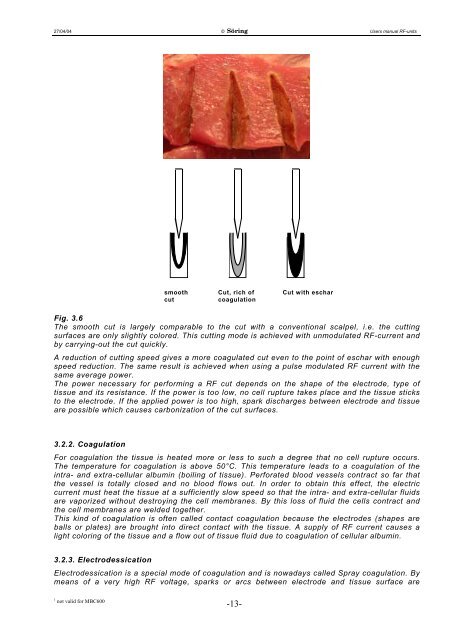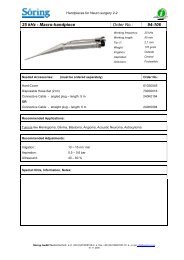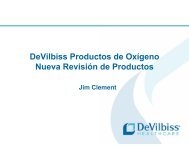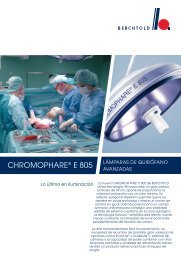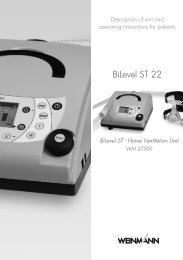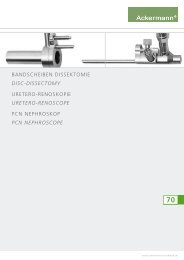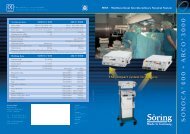USERS MANUAL
USERS MANUAL
USERS MANUAL
You also want an ePaper? Increase the reach of your titles
YUMPU automatically turns print PDFs into web optimized ePapers that Google loves.
27/04/04 © Söring Users manual RF-units<br />
smooth<br />
cut<br />
Cut, rich of<br />
coagulation<br />
Cut with eschar<br />
Fig. 3.6<br />
The smooth cut is largely comparable to the cut with a conventional scalpel, i.e. the cutting<br />
surfaces are only slightly colored. This cutting mode is achieved with unmodulated RF-current and<br />
by carrying-out the cut quickly.<br />
A reduction of cutting speed gives a more coagulated cut even to the point of eschar with enough<br />
speed reduction. The same result is achieved when using a pulse modulated RF current with the<br />
same average power.<br />
The power necessary for performing a RF cut depends on the shape of the electrode, type of<br />
tissue and its resistance. If the power is too low, no cell rupture takes place and the tissue sticks<br />
to the electrode. If the applied power is too high, spark discharges between electrode and tissue<br />
are possible which causes carbonization of the cut surfaces.<br />
3.2.2. Coagulation<br />
For coagulation the tissue is heated more or less to such a degree that no cell rupture occurs.<br />
The temperature for coagulation is above 50°C. This temperature leads to a coagulation of the<br />
intra- and extra-cellular albumin (boiling of tissue). Perforated blood vessels contract so far that<br />
the vessel is totally closed and no blood flows out. In order to obtain this effect, the electric<br />
current must heat the tissue at a sufficiently slow speed so that the intra- and extra-cellular fluids<br />
are vaporized without destroying the cell membranes. By this loss of fluid the cells contract and<br />
the cell membranes are welded together.<br />
This kind of coagulation is often called contact coagulation because the electrodes (shapes are<br />
balls or plates) are brought into direct contact with the tissue. A supply of RF current causes a<br />
light coloring of the tissue and a flow out of tissue fluid due to coagulation of cellular albumin.<br />
3.2.3. Electrodessication<br />
Electrodessication is a special mode of coagulation and is nowadays called Spray coagulation. By<br />
means of a very high RF voltage, sparks or arcs between electrode and tissue surface are<br />
1 not valid for MBC600<br />
-13-


